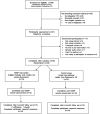Digital Intervention Promoting Physical Activity in People Newly Diagnosed with Parkinson's Disease: Feasibility and Acceptability of the Knowledge, Exercise-Efficacy and Participation (KEEP) Intervention
- PMID: 39093079
- PMCID: PMC11380294
- DOI: 10.3233/JPD-240071
Digital Intervention Promoting Physical Activity in People Newly Diagnosed with Parkinson's Disease: Feasibility and Acceptability of the Knowledge, Exercise-Efficacy and Participation (KEEP) Intervention
Abstract
Background: Exercise promotion interventions for people with Parkinson's disease (PD) are often offered on a face-to-face basis, follow a generic "one-size-fit-all" approach, and are not typically delivered at diagnosis. Considering PD's heterogenous nature, the existing evidence on the merits of exercise on symptom management and the expressed wishes of people living with PD for access to timely and tailored evidence-based information, there is a demand for interventions that are easily accessible, scalable and co-designed with people living with PD.
Objective: Evaluate the feasibility and acceptability of a co-designed digital intervention promoting exercise and physical activity, in people newly diagnosed with PD.
Methods: Thirty people living with PD for less than one year participated in an assessor-blinded randomized feasibility trial from June 2022 to April 2023. The intervention group received the 8-week Knowledge, Exercise Efficacy and Participation (KEEP) intervention comprising 6 interactive digital modules and 4 online live group discussions facilitated by a specialist physiotherapist. Assessments were performed at baseline, post intervention and at 6-month follow up.
Results: Thirty participants were recruited to target with a 64% recruitment rate (30/47). All but one participant completed the 6-month follow-up assessment. There was high retention (97%), module completion (91%), and online discussion attendance (88%). Outcome measure collection was feasible, including accelerometer data with a daily average wear time of 23.9 hours (SD:0.295).
Conclusions: The KEEP intervention was feasible and acceptable in people newly diagnosed with PD. A larger trial is needed to assess intervention efficacy and correlation between knowledge, self-efficacy, and activity levels.
Trial registration: ClinicalTrials.gov NCT05253040.
Keywords: Parkinson’s disease; Physical activity; co-design; digital health; exercise promotion; feasibility study; physical literacy.
Plain language summary
Exercise and physical activity have been found beneficial in managing both motor and non-motor symptoms in people living with Parkinson’s. But there aren’t many programs available right after diagnosis that focus on exercise and explain why it’s important for managing PD symptoms and how to exercise with PD. Most existing programs use a one-size-fit-all approach and don’t give personalized information. In this study, researchers wanted to see if people who were recently diagnosed with PD would join a study promoting exercise through an online program. This program included educational information and live online group discussions with both people living with Parkinson’s and a specialist physiotherapist. The program was developed together with people living with Parkinson’s and healthcare professionals to ensure that it better suited the needs of people newly diagnosed with PD. Thirty people took part in the study. They were randomly put into two groups: one received the online program, while the other group continued with their usual care. Participants filled out questionnaires and wore a wrist accelerometer for seven days to track their physical activity levels. The researchers found that most participants stayed in the study (97%), completed the program modules (91%), and attended the live discussions (88%) and wore the accelerometers for 23.9 hours a day on average. Overall, the study showed that the program was doable and well-received. Participants said they had a better understanding on the benefits of exercise in PD. However, a larger study is needed to see if the program helps increase activity levels.
Conflict of interest statement
The authors have no conflict of interest to report.
Figures





Similar articles
-
Feasibility and acceptability of PDConnect, a multi-component intervention to support physical activity in people with Parkinson's disease: A mixed methods study.J Parkinsons Dis. 2025 May;15(3):603-618. doi: 10.1177/1877718X251324415. Epub 2025 Mar 28. J Parkinsons Dis. 2025. PMID: 40151988 Clinical Trial.
-
Digital adaptation of the Standing up for Myself intervention in young people and adults with intellectual disabilities: the STORM feasibility study.Public Health Res (Southampt). 2024 Jan;12(1):1-111. doi: 10.3310/NCBU6224. Public Health Res (Southampt). 2024. PMID: 38327175
-
Mindfulness in Parkinson's disease: A French national survey and a pilot intervention feasibility trial using the MBSR program (M-Park).Rev Neurol (Paris). 2024 Oct;180(8):777-790. doi: 10.1016/j.neurol.2024.03.013. Epub 2024 May 14. Rev Neurol (Paris). 2024. PMID: 38749789
-
Interventions for promoting physical activity in people with neuromuscular disease.Cochrane Database Syst Rev. 2021 May 24;5(5):CD013544. doi: 10.1002/14651858.CD013544.pub2. Cochrane Database Syst Rev. 2021. PMID: 34027632 Free PMC article.
-
Digital technology for delivering and monitoring exercise programs for people with cystic fibrosis.Cochrane Database Syst Rev. 2023 Jun 9;6(6):CD014605. doi: 10.1002/14651858.CD014605.pub2. Cochrane Database Syst Rev. 2023. PMID: 37294546 Free PMC article. Review.
Cited by
-
Digital health technologies and self-efficacy in Parkinson's: a scoping review.BMJ Open. 2025 Jan 21;15(1):e088616. doi: 10.1136/bmjopen-2024-088616. BMJ Open. 2025. PMID: 39842912 Free PMC article.
-
Exploring how PRIME-Parkinson care is implemented and whether, how and why it produces change, for who and under what conditions: a protocol for an embedded process evaluation within the PRIME-UK randomised controlled trial.BMJ Open. 2025 Feb 2;15(1):e086353. doi: 10.1136/bmjopen-2024-086353. BMJ Open. 2025. PMID: 39894518 Free PMC article.
-
Digital Health in Parkinson's Disease and Atypical Parkinsonism-New Frontiers in Motor Function and Physical Activity Assessment: Review.J Clin Med. 2025 Jun 11;14(12):4140. doi: 10.3390/jcm14124140. J Clin Med. 2025. PMID: 40565895 Free PMC article. Review.
References
Publication types
MeSH terms
Associated data
LinkOut - more resources
Full Text Sources
Medical
Miscellaneous

